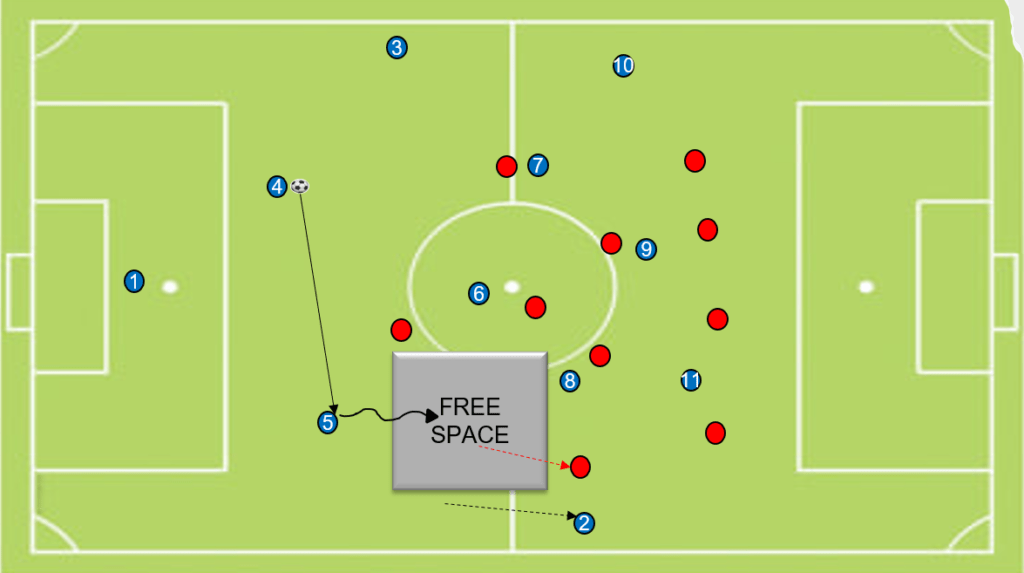Which are the attacking principles in football?
As football coaches, on many occasions, we are lost in the translation. We tend to add too much complexity to our game plan and training exercises and we forget that football is above all a simple invasion game.
The first rule is that whoever scores the most goals or whoever concedes the least wins. There are some very basic ground principles in football coaching that no matter the system, formation, direct or possession soccer, using a high press or low block, always appear. The basic attacking principles, as well as the defending principles, should be trained in academies and to teach young players that football is a simple game.
Even teams such as Manchester United, Tottenham Hotspur, Barcelona, Bayern and Sporting Lisbon with Ruben Amorim, Munich from top leagues like Premier League, La Liga and Bundesliga, they allocate training time during the week for repetition and perfection of this attacking principles. Arsène Wenger build the invincible with a beautiful style of play that was based on player movement, scoring goals and manipulating the opposition defence.
A coach like Pep Guardiola, who is always thinking how to further develop his tactical principles, he never forgets that the main elements of the game, the open play, the counter attack, the goal kick, individual characteristics of an attacker, second balls and opposition team are always presence in a game. From the first moment he joined Man Utd rivals, the Citizens, he implement his own style of play by starting from the basics.
In this article, I will present the 5 main attacking principles in football that every coach should try to include in his training sessions. These principles should be taken seriously into consideration and heavily trained from grassroots until senior teams. These principles are not considered as stand-alone complex tactics but any football philosophy or idea should include them and train them.
Table of Contents
For any coach who wishes to implement a Positional Play style, the below principles are very important to take into consideration. The exercises will help any attacking team to dominate the game.
For a more in-depth study of Positional Play, the book “ How to Train Positional Play – 15 Exercises from Theory to Practice ” can provide you with many details and information, in theory, and in practice with 15 football drills.
How to Train Positional Play – 15 Exercises from Theory to Practice

“The objective is to move the opponent, not the ball” – Guardiola
- What is Positional Play?
- What is the Guardiola Grid?
- Third Man Concept
- Half Spaces
- 15 Positional Play exercises
Width/Depth
The ability to stretch our opponents laterally and vertically across the field. This principle is very important in order to create gaps between the lines and between the players. The team in possession can then take advantage of positional and qualitative superiorities.
The stretching of the opponent’s defensive lines can create gaps for penetration passes or forward runs.

In the above example, #3 and #2 are offering the width in the attacking phase. This allows the wide wingers #11 and #7 to get inside, between the lines, and in the half-spaces. The center forward #9 provides the width. As you can see here, #9 stays intentionally in a slightly offside position making the central defenders wonder where he is and forcing them to get a few steps back, creating more space between the midfield and defending line.
In the first attacking line, the creation of a back three will force the opponents to either:
- Stretched to press the wide center back with the ball, creating space for the defensive midfielder to receive between the lines
- Stay narrow allowing the wide center back to drive forward with the ball
- Allow a switch of play among the back line, finding the free players on the weak side


Below, the team in possession takes advantage of the concentration of the opponents on one side to switch the play to the weak side. The positions of #10 and #7 are very important. One of the superiorities in positional play is Positional Superiority. A player intentionally keeps a position on the pitch in order to create an advantage for himself or his teammates.
Here the two players force the opposition winger and full back to stay narrow and protect the most dangerous area, the central axis. This creates lots of space on the left side lane for the full-back to receive a long diagonal ball. A very important element here is the fast ball circulation towards the weak side so as to not allow the opposition team to shift.

PEP GUARDIOLA ATTACKING TACTICS – TACTICAL ANALYSIS AND SESSIONS FROM MANCHESTER CITY’S 4-3-3

Attacking Tactics from Manchester City’s 4-3-3
- Overcoming the Pressing of the Opposing Forwards
- Positioning and Rotations with Inverted Full Backs
- Creating and Exploiting Overloads in Wide Areas
- Moving the Ball Wide and Receiving in Behind the Full Back (or Create Space for Inside Pass)
- Combination Play Out Wide when the Overload is Blocked
- Stretching the Opposition’s Defence and Switching Play
- Attacking Options when the Attacking Midfielder Receives Between the Lines
- Attacking Through the Centre with the Forward Dropping Back to Receive
- Switching Play to the Weak Side when the Overload is Blocked Against the 4-3-3
Support
Teammates should always be available in supporting positions creating triangles and rhombus, to the side, behind the ball, or in front of the player in possession. This is one of the fundamental attacking principles in football that usually teams who prefer a short passing style heavily pay attention to it but it is also important for any style of play.
This requires good spacial awareness of the pitch when in possession to spread the field. Angles, distance, the timing of passes, and movement without the ball become important.

Penetration
The ability to play through or behind the opposition either with a pass, a forward run or driving with the ball. Exploit space with good on and off-the-ball movement.
One option for penetration may be a player passing between two defenders to break lines. Another option is playing into the space behind as well to find a player further up the field. This attacking principle should always come together with Positional SUperiority. In order for a penetration pass to be successful, players should be positioned behind the defensive lines and between the lines. A penetration pass is so powerful because it can take out the game multiple opponents with just one single attacking action.
An example of how a team may penetrate may be the pivot player, below is the #6, passing the ball to the attacking midfielder #8 into the space behind the midfielder’s line. This pass breaks the midfield line and automatically takes out of the game 4 players.

Below you can find a finishing drill with the intention to first break the lines.
Mobility – Movement without the ball – Positional exchanges
Another important part of the 5 attacking principles in football is the movement without the ball. The interchange positions provide good support and continuation of the play. The players must move in order to create space for themselves or other teammates. Also, movement without the ball aims to create a numerical advantage in specific areas of the pitch.
Players move between lines inside and also in wide spaces to receive the ball or make runs behind the lines. Their movements are coordinated and any positional exchange should aim to maintain the team shape.
Another example may be a player who runs away from the on-ball player in order to create space for his teammate to drive forward. Below are a couple of examples of how players can create space with their movements.



Creativity
The individual and collective ability to provide inventive and unpredictable play, either through individual skills or small group combinations. For example 1vs1’s, 1-2’s, overlaps, underlaps, feint movements, etc.
Here there is no pure team tactical intention and the specific principle is mainly based on the player’s talent. The coach’s responsibility is to build a plan and a way of play in order to take the ball to these players in spaces where they can create opportunities for their teams.
Players like Messi , Neymar , De Bruyne , and Salah are very dangerous for any team because with their creativity they can create a goal scoring opportunity that the opposite team may not be ready to deal with.
Conclusion for the 5 basic attacking principles in football
The 5 main attacking principles in football should provide every coach and player guidance on how to support, create space, and attack during ball possession. However, the soccer coach needs to understand these principles and decide how will implement them in his/her own game model. For example, width and depth can be provided by different players depending on the coach’s style of play. Wingers and full-backs but also wide midfielders can provide the width.
Football is a game during the action a lot of elements are changing so is very important for a coach to provide some very clear instructions that will be a cognitive map for his players to follow. The 5 main attacking principles in football will help them, especially when they are working in youth teams and grassroots level, to stay focused during the game and understand what they should do at any time given.
If you are interested to learn more about Positional Play which includes more information on the basic attacking principles in football you can read the below two articles.
- How to implement Positional Play football with 6 basic variables that a coach can change
- How to implement Positional Play style with the 7 “non-negotiables variables
Read also the “The 4 best Positional Play books – my personal opinion“

